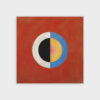Robert Ryman (1930 – 2019) was an American artist primarily associated with Monochrome Painting, Minimalism, and Conceptual Art. He pushed the boundaries of visual experience and focused heavily on the materiality and sensory quality of his works. He became best known for his lifelong exploration of the color white.
Ryman was born on May 30, 1930, in Nashville, Tennessee. He studied music and actually had the dream of becoming a jazz musician. In 1952, he moved to New York. His entry into art began rather accidentally, when, while pursuing his music career in New York, he kept his head above water as a security guard at the Museum of Modern Art. His encounters with modern art shaped Ryman’s perspective and eventually, his own artistic practice.
In particular, his encounter with Mark Rothko’s No. 10 at the age of 22 changed Ryman’s attitude to art forever: he was deeply fascinated by the presence of Rothko’s paintings and the way they interacted with light.1 To Robert Storr, American curator, critic, painter, and writer, he once commented: “Rothko was different in that his painting was not abstracted from anything representational. This was very different from what I had been looking at…His work wasn’t like a picture-like the usual pictures I had seen. That was a revelation.”1
Over the course of his career, Ryman experimented with different media and materials. While his early works were primarily orange, he used a variety of whites later in his career.2 He applied them in numerous shades and textures to a wide range of media, including canvas, aluminum, and newsprint. He thus explored their effect on the viewer as well as the subtle differences in texture, materiality, and luminosity.
I don’t like this word abstract…but I use it because people…have an idea what I’m talking about.1
He had his first exhibition in 1967 at the Paul Bianchini Gallery in New York City and his first retrospective at the Guggenheim Museum in 1972. Ryman was often classified as a minimalist, but he preferred to call himself a “realist.” He explained that he was not interested in creating illusions, but in representing the materials he used in his compositions at their real value. Also, the titles of his works are often generic words or simply the names of art materials or companies. For him, they were meaningless and served only for identification.3
In addition to his work in painting, Ryman also explored printmaking, creating etchings, aquatints, and lithographs. Again, his attention was focused on the specific qualities of each medium and process, and he emphasized the need to look deeper and see the subtleties in his work.
Robert Ryman passed away on February 8, 2019, and his subtle white-on-white compositions continue to challenge our understanding of color, composition, and materiality. In doing so, he made a significant contribution to Abstract Art and Minimal Art: rather than focusing on symbolic or representational imagery, he focused on the physical act of painting itself-specifically, the application of paint to a surface. His honest and authentic approach to his work leaves an important legacy in the world of fine art.


